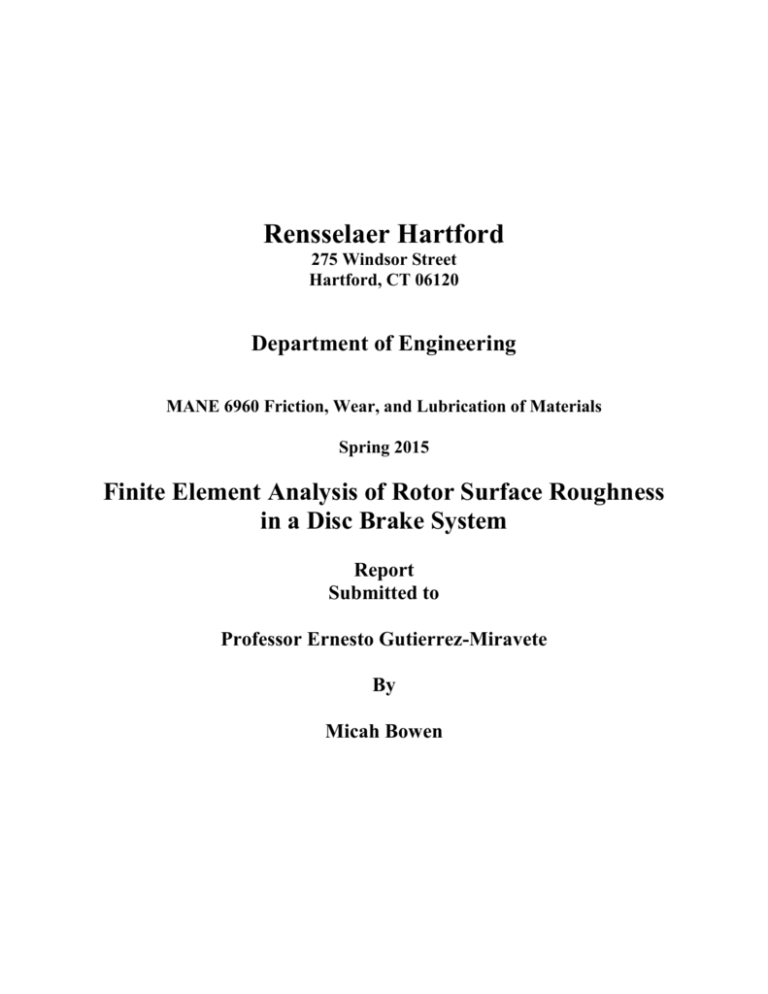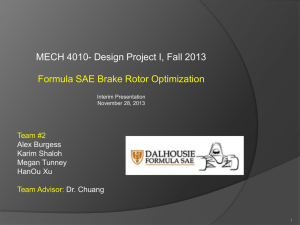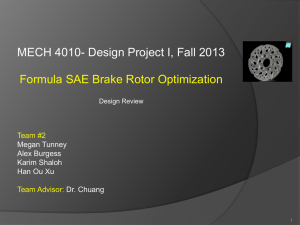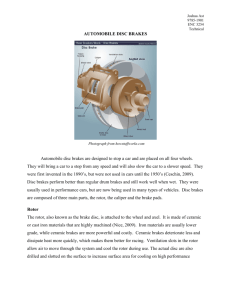Figure 14: Meshing of the Brake Pad and Rotor
advertisement

Rensselaer Hartford 275 Windsor Street Hartford, CT 06120 Department of Engineering MANE 6960 Friction, Wear, and Lubrication of Materials Spring 2015 Finite Element Analysis of Rotor Surface Roughness in a Disc Brake System Report Submitted to Professor Ernesto Gutierrez-Miravete By Micah Bowen Finite Element Analysis of Rotor Surface Roughness in a Disc Brake System Bowen, S2015 Abstract The purpose of this project was to analyze a disc brake system using finite element analysis (FEA) to determine the effects of different values of rotor surface roughness on the system. This was accomplished by creating a geometric model of a two blocks representing the disc brake system and varying the heights of the block surfaces representing different values of surface roughness. The model was meshed, the material properties for a ceramic brake pad and grey cast iron rotor were applied, and boundary condition using the FEA software package ANSYS Workbench 14.5. Displacements were applied to one of the blocks while the other block was fixed representing a brake clamping on the spinning rotor, as shown in Figure 6. All ANSYS models were isothermal 2D models solve using a static analysis to generate stress and deflection plots. It was determined that a significant number of test cases, many more than the nine performed in this report are required to make a conclusion on the impact of surface roughness. Peaks in the force required to displace the brake pad across the rotor are due to peaks in the rotor surface rather than the actual roughness average (RA). A summary of the data is found in the results and discussion part of this report. Introduction A vehicle brake disc system is comprised of a caliper, piston, brake pad, and rotor as shown in Figure 1. When the brake pedal is pressed, a hydraulic piston pushes the brake pad against the brake disc or rotor attached to the wheel. The friction generated between the brake pad and rotor slows the rotational velocity of the rotor and attached wheel. Figure 1: Typical Car Disk Brake Setup [1] The friction between a brake pad and rotor produces a large amount of heat that is absorbed by the rotor and cooled by the passing air. The ability to dissipate heat is key the efficiency of the system. If the rotor 1 Finite Element Analysis of Rotor Surface Roughness in a Disc Brake System Bowen, S2015 does not have proper airflow and/or overheats, the rotor can warp. To prevent these thermal issues, manufactures have developed multiple rotor designs for various vehicle applications as shown in Figure 2. Slotted and drilled rotors designs are used to assist in the removal of heat and gases generated in the system. However, the downside of these designs is the slots and holes weaken the rotor resulting in cracking and eventual failure. These designs are suited for applications such as racing where the rotors undergo high stress and generate a great amount of heat. For daily drivers, a vented rotor is the ideal. The vented rotor has slotted areas on its edge that increase the heat dissipation in the system without weakening the rotor. Figure 2: Vented, Drilled, and Slotted Rotors [3], [4], & [5] A brake pad consists of a friction material attached to a steel backing that is attached to the caliper-piston as shown in Figure 3. Attached to the brake pad is a metal clip called a wear indicator that comes into contact with the rotor surface when the brake pad wears down to the minimum operational thickness. The contact between the wear indicator and rotor results in a loud squealing sound to notify the operator that the brake pads need to be replaced. Figure 3: Brake Pads [2] In addition to the reduction thickness of the rotor and brake pad, scoring and wear ridges will appear on the rotor as the system wears as shown in Figure 4. Typically, a rotor lasts through two sets of brake pads. After the first set of brake pads has worn, it is recommended to resurface the rotor as long as the thickness of the rotor is greater than the specified original equipment manufacturer (OEM) thickness after being resurfaced. 2 Finite Element Analysis of Rotor Surface Roughness in a Disc Brake System Bowen, S2015 Figure 4: Brake Disc Wear [10] The recommended surface finish for a resurfaced rotor is between 30 and 60 RA [9]. Surface roughness is the measurement of surface irregularities in the surface texture. The RA is the arithmetic average deviation of the surface valleys and peaks expressed in micro inches [11]. RA is calculated using Equations 1 and 2 using the variables in Figure 5. 𝑀𝑒𝑎𝑛 𝐿𝑖𝑛𝑒 = ∑𝑖=1 𝑛 𝑅𝐴 = ∑𝑖=1 𝑛 𝑦1 +𝑦2 +𝑦𝑛 𝑛 |ℎ1 |+|ℎ2 |+|ℎ𝑛 | 𝑛 Equation 1 = 𝜇 · 𝑖𝑛 Equation 2 In the previous equations: yn = measure height from datum to top surface (in) hn = calculated height from mean line to top surface (in) n = number of samples Varied Surface h1 h3 hn Datum y1 y1 Mean Line yn Figure 5: Diagram of Surface Roughness 3 Finite Element Analysis of Rotor Surface Roughness in a Disc Brake System Bowen, S2015 The rotor material depends on the application, but is commonly made out of grey iron for the automotive industry. Grey iron is a desirable material for this application based on its metallurgical properties such as strength, noise, vibration damping capabilities, and wear [6] & [7]. In addition, they are low cost to produce. Some other rotor materials are stainless steel and aluminum. Stainless steel is used in applications where weight and preventing rust is important such as bicycles. The downside to stainless steel is it does not absorb heat (low thermal conductivity) and other material properties leading to much more wear compared to other metals. Aluminum and layered aluminum/steel rotors are used in applications such as motorcycles where the combination of lightweight and thermal material properties such as ability to dissipate heat and thermal expansion are important. There are three main types of brake pad materials commonly used: semi-metallic, fully metallic, and ceramic [8]. Semi-metallic brake pads consist of synthetics mixed with flaked metals resulting in a material that is harder and lasts longer than non-metallic pads. The semi-metallic brake pads are less expensive compared to other brake pads materials. Fully metallic brake pads are composed of steel and are ideal for racing applications where significant braking power is required. The downside with fully metallic brake pads is the increased rotor wear. Ceramic brake pads are constructed from a blend of ceramic and copper fiber and are desirable over metallic brake pads due to the fact they are quieter, create less dust, and last longer than metallic brake pads. Ceramic brake pads are not recommended for racing or heavy duty use due to the fact they do not have a good “bite” for quick braking compared to metallic. The purpose of this project is to analyze a disc brake system using FEA in ANSYS Workbench 14.5 to determine the effects of different values of rotor surface roughness on the system. This will be accomplished by representing the system as two blocks shown in Figure 6. One block will be fixed in all degrees of freedom (DOF) at the bottom and one side. It will have a varied top surface height representing the rotor surface roughness. The second block will be aligned horizontally with the first block at a prescribed height. A displacement will be applied to the block to displace it in the -Y-direction to the mean line height of the rotor. Once displaced, a second displacement will be applied to the block in the +X-direction and force probe will be used to determine the amount of force required to displace the brake pad block. In addition, von Mises stress will be pulled to determine the stresses of both the pad and rotor. Multiple cases will be run for different surface roughness and compared each other as well as to a baseline ideal case (rotor surface is flat). Piston Displacement Piston Displacement Distance Mean Line Height Y + X Block Representing Brake Pad Block Representing Rotor Force Probe Prescribed Displacement Varied Surface Roughness Fixed Surfaces Figure 6: Block Model Representing Brake Disc System Figure 7 shows a breakdown of each step in the proposed FEA. 4 Finite Element Analysis of Rotor Surface Roughness in a Disc Brake System Initial Setup Bowen, S2015 Displacement in -Y-direction Block Representing Brake Pad Block Representing Rotor Y + X Displacement in X-direction = 0 Displacement in -Y-direction Displacement in +X-direction Force Probe Figure 7: FEA Steps A prescribed displacement in the Y-direction will be used opposed to a force representing the piston force due to the fact that applying a force in the Y-direction will result in brake pad contacting the varied rotor surface at the rotor surface peak as shown in Figure 8. The resulting extracted force would not represent a varied surface, but would represent the force required to drag the brake pad across the rotor surface peak. Figure 8: Using Force Instead of Displacement for the Brake Pad 5 Finite Element Analysis of Rotor Surface Roughness in a Disc Brake System Bowen, S2015 This project considers a standard vented rotor design and solid brake pad shown in Figure 2 and Figure 3. The material properties in Table 1 for a grey iron rotor and ceramic brake pad will be used. Table 1: Rotor and Brake Pad Material Properties Material Density (ρ) (kg/m3) Young’s Modulus (E) (GPa) Tensile Strength (σu) (MPa) Yield Strength (σy) (MPa) Poisson’s Ratio (ν) 3700 303 193 15,400 0.21 207 172.37 (min) Aluminum Oxide AI203 (Ceramic) (1) SAE(4) J431 G3000 (Grey Cast Iron)(2) 7150 140 Coefficient of Friction (μ) 0.3 – 0.5(3) 0.24 Notes: 1. Values for 94% aluminum oxide from [15]. Yield strength from [16]. 2. Values from [13]. Yield strength from [14]. 3. Values from [17]. 4. Society of American Engineers (SAE). Heat transfer between the brake pad and rotor as well as the heat transfer to the surrounding air is outside the scope of this project. For this study please see the following reference [12]. Formulation and Solution Figure 9 shows the dimensions for the blocks representing the brake pad and rotor. These dimensions were chosen to ensure the extracted von Mises stress distribution would not be impacted by edge effects. 2.00 in 1.00 in Prescribed Block Representing Displacement Brake Pad Distance 1.00 in Block Representing Rotor Mean Line Height 2.00 in Figure 9: Block Dimensions Typical values of surface roughness of the rotor were calculated using excel by splitting the 2.00 in length of the rotor into 10 segments (0.2 in) and using the random function. Ten segments were selected since it produced a realistic surface roughness. If too many segments were created, there would be too much variation in the surface height as shown in Figure 10 and the rotor could not be properly meshed. 6 Finite Element Analysis of Rotor Surface Roughness in a Disc Brake System Bowen, S2015 1.000 Height of Rotor (in) 1.000 1.000 Rotor Height 1,000 Divisions 1.000 Mean Line 1.000 1.000 1.000 0.000 0.200 0.400 0.600 0.800 1.000 1.200 1.400 1.600 1.800 2.000 Distance Along Rotor (in) 1.000 Height of Rotor (in) 1.000 1.000 Rotor Height 10 Divisions 1.000 Mean Line 1.000 1.000 1.000 0.000 0.200 0.400 0.600 0.800 1.000 1.200 1.400 1.600 1.800 2.000 Distance Along Rotor (in) Figure 10: Comparison of 1,000 versus 10 Segment Split Up The variation in surface height was created by using the RANDOMBETWEEN function in excel and multiplying by a factor to create the random surface heights. The mean line height and surface roughness was calculated using Equations 1 and 2. This was done for multiple values of surface roughness from approximately 15 to 92 RA. Since the surface roughness heights vary on such a small scale (1e-4) in comparison to the size of the model, the surface height variations were multiplied by 500 in order to get amplified output from the FEA models. Using SolidWorks, the geometry from Figure 7 was constructed using the rotor heights from Excel. These values were imported into SolidWorks as XYZ points in and a spline was used to connect the lines as shown in Figure 11. In addition, the corner of the brake pad block was rounded to avoid a concentration point at the corner when in contact with the rotor. Once the dimensions and lines are defined, the blocks were turned into surfaces and exported to ANSYS Workbench 14.5 as an IGS file. 7 Finite Element Analysis of Rotor Surface Roughness in a Disc Brake System Bowen, S2015 Figure 11: SolidWorks Block Setup Once in ANSYS Workbench 14.5, a 2D elastic static structural analysis was selected and the material properties from Table 1 were assigned. Next the IGES file from SolidWorks was imported and the material properties were assigned. The next step was to setup the contact between the two surfaces as shown in Figure 12. This was accomplished by setting the brake pad and rotor blocks as contact and target edges/bodies. A frictional contact with a friction coefficient of 0.4 (average value from Table 1) was set. A pure penalty method was selected with a pinball region setup to capture both surfaces that will come into contact. Figure 12: Contact Setup between Brake Pad and Rotor 8 Finite Element Analysis of Rotor Surface Roughness in a Disc Brake System Bowen, S2015 The contact tool status and initial gaps are shown in Figure 13. The contact tool is used to ensure that the selected edges that will come into contact are setup correctly. Figure 13: Contact Tool Checks Next a mesh was setup as shown in Figure 14. This was accomplished by selecting the edges of the blocks and setting the number of divisions. A bias type was set in order to have a denser mesh toward the varied (top) surface of the rotor. Mid-side nodes were kept due to the fact that the varied surface of the rotor will result in tetrahedral elements along the surface; using mid-side nodes is important when dealing with tetrahedral elements to properly predict the stress. An element quality check was performed to ensure proper element shapes. To confirm that accurate results are obtained, a mesh density study for one of the cases was performed in Appendix B. Figure 14: Meshing of the Brake Pad and Rotor 9 Finite Element Analysis of Rotor Surface Roughness in a Disc Brake System Bowen, S2015 The next step was to setup the applied displacements and boundary conditions on the rotor and brake pad as shown in Figure 15. The left side and bottom of the rotor was fixed in all degrees of freedom (Fixed Support-A). A displacement of 2.0 inches in the X-direction was applied to the right edge of the brake pad (Displacement 3-C). Another displacement was applied to the top of the brake pad that is equal to 1.10 inches from Figure 11 minus the mean line height (Displacement 4-B). Figure 15: Applied Displacement, Force, and Fixed Support on the Rotor and Brake Pad The step times used for the applied force and displacement are shown in Figure 16. For the displacement, the first five steps (0.5 seconds) was set to displace the brake pad 0.1 inches for this case, which bring it to the mean line height of the rotor. At 0.5 seconds, the 2.0 inch displacement in the +X-direction was applied. 10 Finite Element Analysis of Rotor Surface Roughness in a Disc Brake System Bowen, S2015 Figure 16: Step Setups for Force and Displacement The typical analysis settings are shown in Figure 17. The values for the times varied from case to case based on the force and displacement step times. Multiple steps were used in order for the problem to converge. In addition, large deflection was turned on while the weak springs were turned off in the solver controls. Figure 17: Setup for Analysis 11 Finite Element Analysis of Rotor Surface Roughness in a Disc Brake System Bowen, S2015 The next step was to set up the solution portion or the FEA. As discussed in the Introduction portion of this report, the force required to displace the brake pad and von Mises stress plots are required for postprocessing. This was accomplished by selecting a force probe and applying it to the displaced edge of the brake pad as shown in Figure 18. The equivalent stress (von Mises) plots were selected for all bodies Figure 18: Force Probe Setup Once the analysis was completed, the solution information was checked to ensure there were no errors and that the problem properly converged as shown in Figure 19. Figure 19: FEA Convergence 12 Finite Element Analysis of Rotor Surface Roughness in a Disc Brake System Bowen, S2015 Results The post-processing results are tabulated in Table 2 and plotted in Figure 20. An outline of the generated surfaces is shown in Figure 21 through Figure 27. The post-processing averages the force from the force probe across all the time steps in order to reduce the impact by outlying peaks in the surface on the force. Based on the plot in Figure 20, no conclusions can be made from the data due to the fact a significant number of test cases would be needed. This is due to the peaks in force that result from peaks in the surface. An example of this is shown in Case 02 which is plotted in Figure 22. Case 02 has a significant peak at the start and end of the surface which required a significant amount of force to displace the brake pad. If a significant number of test cases were made and a larger data sample was available, the outlying peaks could be rules out using a normal distribution curve. Table 2: Post-processing Data for Cases(2) Case Surface Roughness Value (RA) Mean Line Height (in) Average Absolute Force (lbf) 851 1,523 386 1,535 2,724 609 2,749 777 8 1.00000 0.0 (Ideal)(1) 4 1.00001 16.0 3 1.00000 25.8 1 1.00000 37.3 2 1.00000 51.0 5 0.99994 66.3 6 1.00002 77.6 7 1.00001 92.3 Notes: 1. An additional 0.1 inch in displacement was added to generate a force. 2. Tabulated from minimum to maximum surface roughness 13 Finite Element Analysis of Rotor Surface Roughness in a Disc Brake System Bowen, S2015 6 2 4 1 7 8 5 3 Height of Rotor (in) Figure 20: Average Absolute Force versus Surface Roughness 1.00010 1.00008 1.00006 1.00004 1.00002 1.00000 0.99998 0.99996 0.99994 0.99992 0.99990 0.99988 0.000 Surface Mean Line 0.500 1.000 1.500 2.000 Distance Along Rotor (in) Figure 21: Case 01 Rotor Surface 14 Finite Element Analysis of Rotor Surface Roughness in a Disc Brake System Bowen, S2015 Height of Rotor (in) 1.00010 1.00005 1.00000 Surface 0.99995 Mean Line 0.99990 0.99985 0.000 0.500 1.000 1.500 2.000 Distance Along Rotor (in) Figure 22: Case 02 Rotor Surface 1.00008 Height of Rotor (in) 1.00006 1.00004 1.00002 1.00000 Surface 0.99998 0.99996 Mean Line 0.99994 0.99992 0.99990 0.99988 0.000 0.500 1.000 1.500 2.000 Distance Along Rotor (in) Figure 23: Case 03 Rotor Surface 1.00005 Height of Rotor (in) 1.00004 1.00003 1.00002 Surface 1.00001 1.00000 Mean Line 0.99999 0.99998 0.99997 0.99996 0.000 0.500 1.000 1.500 2.000 Distance Along Rotor (in) Figure 24: Case 04 Rotor Surface 15 Finite Element Analysis of Rotor Surface Roughness in a Disc Brake System Bowen, S2015 Height of Rotor (in) 1.00005 1.00000 0.99995 Surface 0.99990 Mean Line 0.99985 0.99980 0.000 0.500 1.000 1.500 2.000 Distance Along Rotor (in) Figure 25: Case 05 Rotor Surface 1.00020 Height of Rotor (in) 1.00015 1.00010 1.00005 Surface 1.00000 0.99995 Mean Line 0.99990 0.99985 0.99980 0.99975 0.000 0.500 1.000 1.500 2.000 Distance Along Rotor (in) Figure 26: Case 06 Rotor Surface 1.00025 Height of Rotor (in) 1.00020 1.00015 1.00010 1.00005 Surface 1.00000 0.99995 Mean Line 0.99990 0.99985 0.99980 0.99975 0.000 0.500 1.000 1.500 2.000 Distance Along Rotor (in) Figure 27: Case 07 Rotor Surface Post-processing shows that the contact setup is functioning correctly as shown in the von Mises stress plot, Figure 28 and the rotor surface is yielding at the surface peaks. These surface peaks lead to the spikes in force required to displace the brake pad across the surface. In addition, using displacement 16 Finite Element Analysis of Rotor Surface Roughness in a Disc Brake System Bowen, S2015 instead of force on the brake pad allows for contact across multiple surface peaks versus a single peak shown in Figure 8. Figure 28: Contact and Yielding in Case 03 Conclusion The surface roughness of a rotor has a significant impact on the efficiency and wear of a brake system. It is important to follow the guidelines [9] for rotor surface roughness values when performing maintenance on a brake system. When modeling a brake system, getting the model to converge when using contact is extremely difficult and time intensive. If this project was repeated, more test cases would be needed to make a conclusion. A future recommendation for this project would be to include the thermal effects on the disc brake system by including the heat generated by friction and by varying the thickness of the rotor and determining how this impacts the efficiency and wear of the system. In addition to the thermal effects, analyzing the wear of rotors that have been slotted or drilled, a process used to help dissipate heat, but make the rotor prove to cracking. 17 Finite Element Analysis of Rotor Surface Roughness in a Disc Brake System Bowen, S2015 References 1. Diskbrake3new-3. Digital image. Olathetoyota. N.p., n.d. Web. 9 Apr. 2015. <https://parts.olathetoyota.com/images/2014/03/discbrake3new-3.jpg>. 2. Digital image. How Stuff Works. N.p., n.d. Web. 18 Apr. 2015. <http://s.hswstatic.com/gif/brakepads-1.jpg>. 3. Power Stop Slotted Brake Rotors. Digital image. Brake Wearhouse. N.p., n.d. Web. 13 Apr. 2015. <http://www.brakewarehouse.com/images/powerstop/slotted.jpg>. 4. Stainless Steel Cross Drilled Rotors. Digital image. Performance Parts News. N.p., n.d. Web. 13 Apr. 2015. <http://performanceparts.com/News/wp-content/uploads/2012/01/cross-drilledrotor.jpg>. 5. Brake Rotor (10.1" Vented-OEM). Digital image. Techtonics Tuning. N.p., n.d. Web. 13 Apr. 2015. <http://techtonicstuning.com/main/images/615.115.jpg>. 6. Aravind Vadiraj, G.Balachandran, M.Kamaraj, B.Gopalakrishna, D.Venkateshwara Rao, "Wear behavior of alloyed hypereutectic gray cast iron", Tribology International 43 (2010) 647–653. 7. Aravind Vadiraj, G. Balachandran, M. Kamaraj, B. Gopalakrishna, K. Prabhakara Rao, "Studies on mechanical and wear properties of alloyed hypereutectic gray cast irons in the as-cast pearlitic and austempered conditions", Materials and Design 31 (2010) 951–955. 8. "What Are The Best Brake Pads: Ceramic or Semi-Metallic?" What Are The Best Brake Pads? Ceramic vs. Semi-Metallic. N.p., n.d. Web. 18 Apr. 2015. <http://www.autoanything.com/brakes/the-best-brake-pads-ceramic-or-metallic.aspx>. 9. "Brake Rotors." Brake Rotors. N.p., n.d. Web. 18 Apr. 2015. <http://www.aa1car.com/library/brake_rotors.htm>. 10. Digital image. Implass Form. N.p., n.d. Web. 18 Apr. 2015. <http://blog.bavauto.com/wpcontent/uploads/2009/11/fig-71.jpg>. 11. "Surface Roughness (Finish) Review and Equations - Engineers Edge." Surface Roughness (Finish) Review and Equations - Engineers Edge. N.p., n.d. Web. 19 Apr. 2015. <http://www.engineersedge.com/surface_finish.htm>. 12. Lipert, R. (1999). Brake Design and Safety (2nd. Ed.). Warrendale, Pa.: Society of Automotive Engineers. 13. Materials for Engineering: Concepts and Applications, L. H. Van Vlack, Addison-Wesley Publishing Company, Reading, MA (1982). 14. Iron and Steel Specifications. London: British Steel, Head Office Standards, 1989. Web. 19 Apr. 2015. 15. Porcelain, and Mullite. "8510-1042 Ceramic Material Properties." Coorstek.com. N.p., n.d. Web. 19 Apr. 2015. <http://www.coorstek.com/resource-library/library/85101042_ceramic_material_properties.pdf>. 18 Finite Element Analysis of Rotor Surface Roughness in a Disc Brake System Bowen, S2015 16. "Material: Aluminum Oxide (Al2O3), Bulk." Material: Aluminum Oxide (Al2O3), Bulk. N.p., n.d. Web. 20 Apr. 2015. <https://www.memsnet.org/material/aluminumoxideal2o3bulk/>. 17. Eltayeb, N., & Liew, K. (2009). On The Dry and Wet Sliding Performance of Potentially New Frictional Brake Pad Materials For Automotive Industry. Wear, 266 (1-2), 275-287 Melaka, Malaysia. 19 Finite Element Analysis of Rotor Surface Roughness in a Disc Brake System Bowen, S2015 Appendix A: Excel Code Figure A-1: Excel Setup for Random Rotor Height 20 Finite Element Analysis of Rotor Surface Roughness in a Disc Brake System Bowen, S2015 Appendix B: Mesh Study In the case of contact, mesh density is extremely important to output the correct stress. As discussed in the Formulation and Solution section of this report, a mesh density study is performed to ensure the stresses are being properly predicted. Table B tabulates the mesh densities and force required to displace the brake rotor. Figure B shows the difference in stress plots between the cases. The mesh study was performed using Case 1 from the Results section of this report. Table B: Mesh Density Study Category Mesh 1(2) Mesh 2 Mesh 3 Elements 7105 10008 11054 Nodes 7399 11052 12350 -1535 -1580 -1603 N/a 2.9 4.4 Force (lbf) Percent Difference (%) (1) Notes: 1. Percent Difference is calculated as: (MeshX / Mesh1 - 1) × 100. 2. Mesh used in analysis in Results section of this report. 1,600 Absolute Force (lbf) 1,590 1,580 1,570 1,560 1,550 1,540 1,530 0 2,000 4,000 6,000 8,000 10,000 12,000 14,000 Nodes Figure B: von Mises Stress Plots Table B shows that there is a 5.0% difference in the force; therefore, the use of Mesh 1 is justified. In addition the plots in Figure B show the von Mises stress does not vary significantly at the peaks of the varied rotor surface. 21








